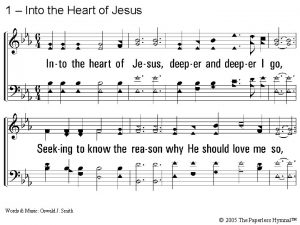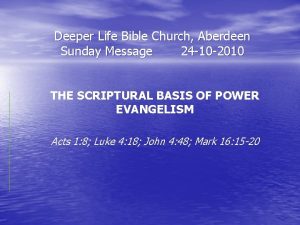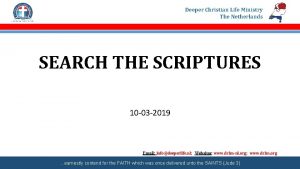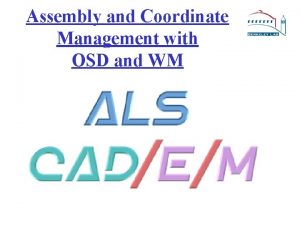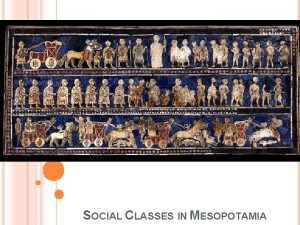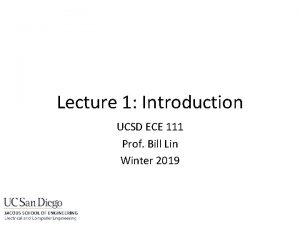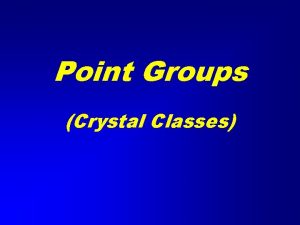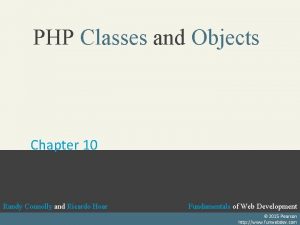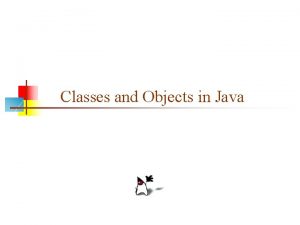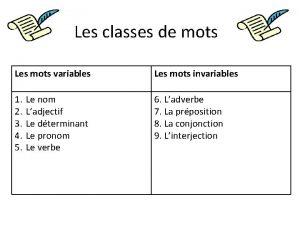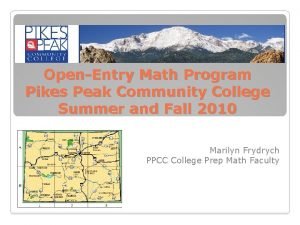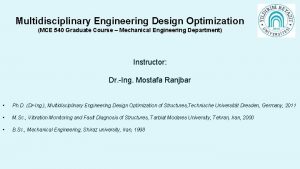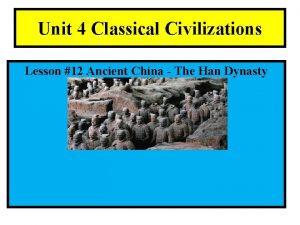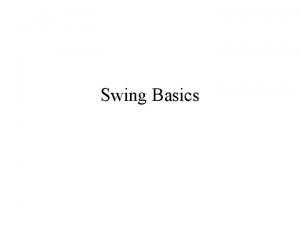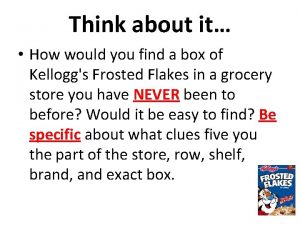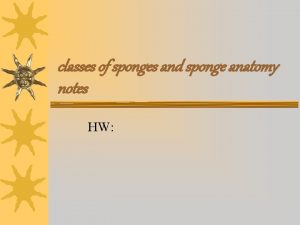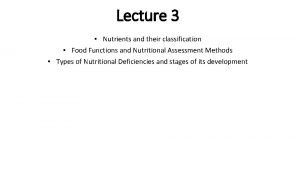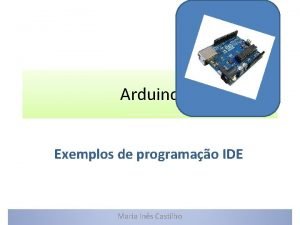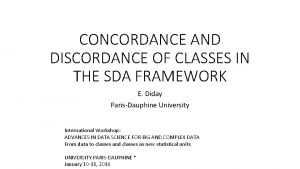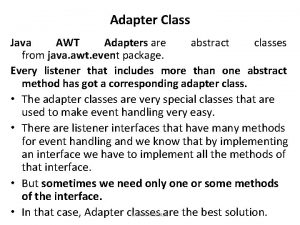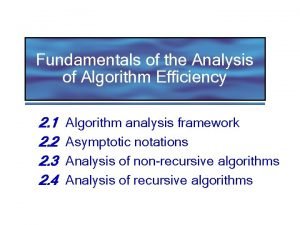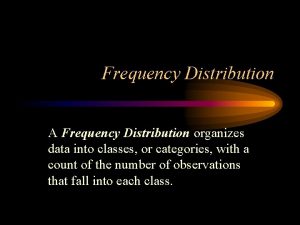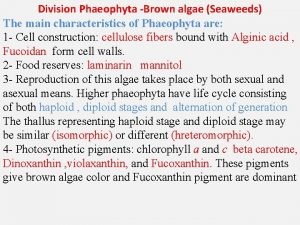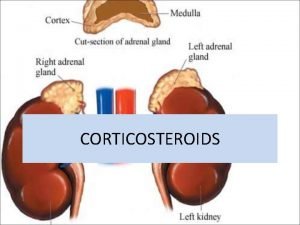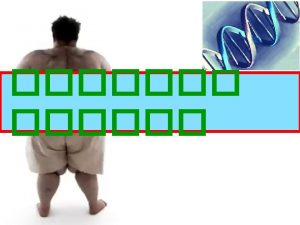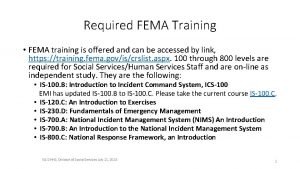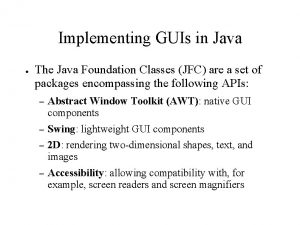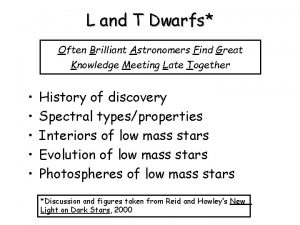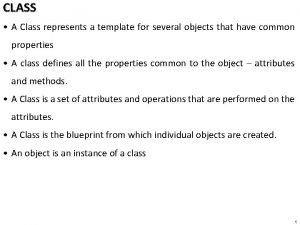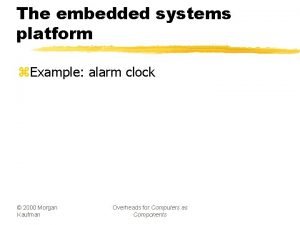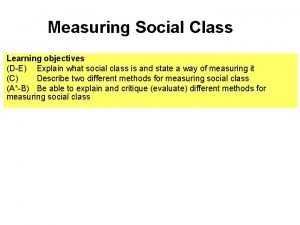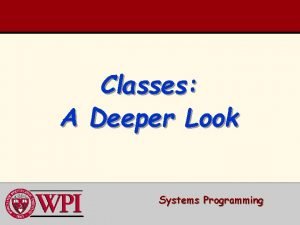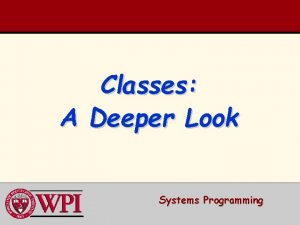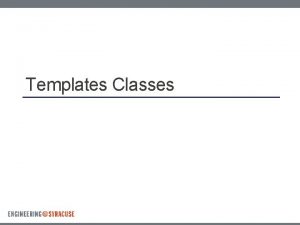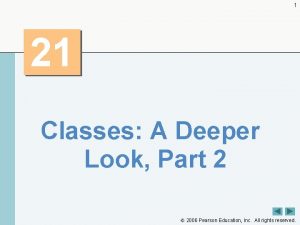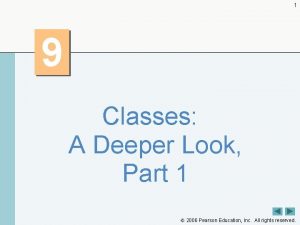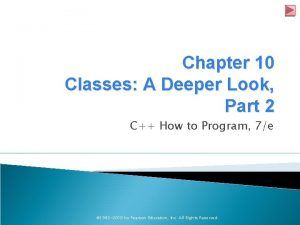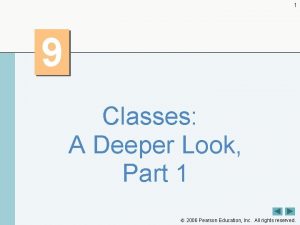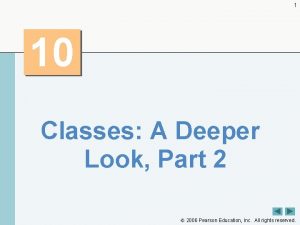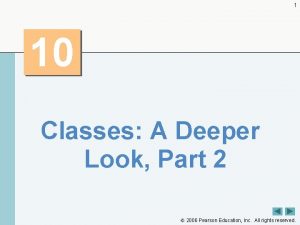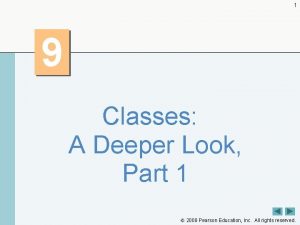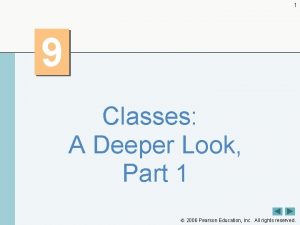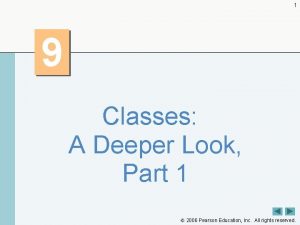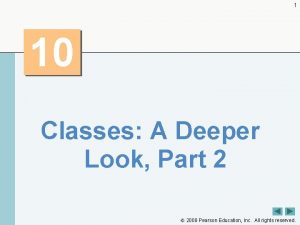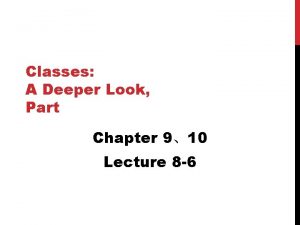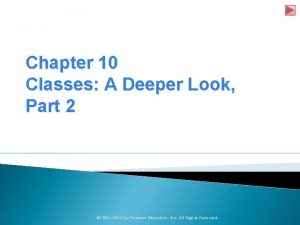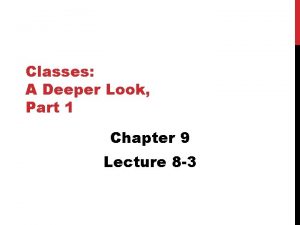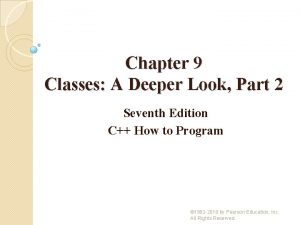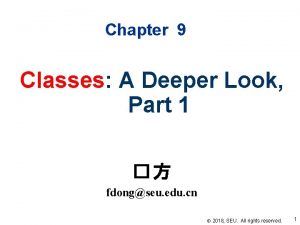1 10 Classes A Deeper Look Part 2
















































































![81 Common Programming Error 10. 9 Using delete instead of delete [] for arrays 81 Common Programming Error 10. 9 Using delete instead of delete [] for arrays](https://slidetodoc.com/presentation_image/027f768298e866234daa91bf56b4f4fe/image-81.jpg)



































- Slides: 116

1 10 Classes: A Deeper Look, Part 2 2008 Pearson Education, Inc. All rights reserved.

2 But what, to serve our private ends, Forbids the cheating of our friends? — Charles Churchill Instead of this absurd division into sexes they ought to class people as static and dynamic. — Evelyn Waugh Have no friends not equal to yourself. — Confucius 2008 Pearson Education, Inc. All rights reserved.

3 OBJECTIVES In this chapter you will learn: § To specify const (constant) objects and const member functions. § To create objects composed of other objects. § To use friend functions and friend classes. § To use this pointer. § To create and destroy objects dynamically with operators new and delete, respectively. § To use static data members and member functions. § The concept of a container class. § The notion of iterator classes that walk through the elements of container classes. § To use proxy classes to hide implementation details from a class's clients. 2008 Pearson Education, Inc. All rights reserved.

4 Introduction 10. 1 10. 2 const (Constant) Objects and const Member Functions 10. 3 Composition: Objects as Members of Classes 10. 4 friend Functions and friend Classes 10. 5 10. 6 Dynamic Memory Management with Operators new and delete static Class Members 10. 7 10. 8 10. 9 Using the this Pointer Data Abstraction and Information Hiding 10. 8. 1 10. 8. 2 Example: String Abstract Data Type 10. 8. 3 Example: Queue Abstract Data Type Example: Array Abstract Data Type Container Classes and Iterators 10. 10 Proxy Classes 10. 11 Wrap-Up 2008 Pearson Education, Inc. All rights reserved.

5 10. 1 Introduction • const objects and const member functions – Prevent modifications of objects – Enforce the principle of least privilege • Composition – Classes having objects of other classes as members • Friendship – Enables class designer to specify that certain non-member functions can access the class’s non-public members 2008 Pearson Education, Inc. All rights reserved.

6 10. 1 Introduction (Cont. ) • this pointer • Dynamic memory management – new and delete operators • static class members • Proxy classes – Hide implementation details of a class from clients • Pointer-base strings – Used in C legacy code from the last two decades 2008 Pearson Education, Inc. All rights reserved.

10. 2 const (Constant) Objects and const Member Functions 7 • Principle of least privilege – One of the most fundamental principles of good software engineering – Applies to objects, too • const objects – Keyword const – Specifies that an object is not modifiable – Attempts to modify the object will result in compilation errors 2008 Pearson Education, Inc. All rights reserved.

8 Software Engineering Observation 10. 1 Declaring an object as const helps enforce the principle of least privilege. Attempts to modify the object are caught at compile time rather than causing execution-time errors. Using const properly is crucial to proper class design, program design and coding. 2008 Pearson Education, Inc. All rights reserved.

9 Performance Tip 10. 1 Declaring variables and objects const can improve performance—today’s sophisticated optimizing compilers can perform certain optimizations on constants that cannot be performed on variables. 2008 Pearson Education, Inc. All rights reserved.

10. 2 const (Constant) Objects and const Member Functions (Cont. ) 10 • const member functions – Only const member function can be called for const objects – Member functions declared const are not allowed to modify the object – A function is specified as const both in its prototype and in its definition – const declarations are not allowed for constructors and destructors 2008 Pearson Education, Inc. All rights reserved.

11 Common Programming Error 10. 1 Defining as const a member function that modifies a data member of an object is a compilation error. 2008 Pearson Education, Inc. All rights reserved.

12 Common Programming Error 10. 2 Defining as const a member function that calls a non-const member function of the class on the same instance of the class is a compilation error. 2008 Pearson Education, Inc. All rights reserved.

13 Common Programming Error 10. 3 Invoking a non-const member function on a const object is a compilation error. 2008 Pearson Education, Inc. All rights reserved.

14 Software Engineering Observation 10. 2 A const member function can be overloaded with a non-const version. The compiler chooses which overloaded member function to use based on the object on which the function is invoked. If the object is const, the compiler uses the const version. If the object is not const, the compiler uses the non-const version. 2008 Pearson Education, Inc. All rights reserved.

15 Common Programming Error 10. 4 Attempting to declare a constructor or destructor const is a compilation error. 2008 Pearson Education, Inc. All rights reserved.

Outline 16 Time. h (1 of 2) const keyword to indicate that member function cannot modify the object 2008 Pearson Education, Inc. All rights reserved.

Outline 17 Time. h (2 of 2) 2008 Pearson Education, Inc. All rights reserved.

Outline 18 Time. cpp (1 of 3) 2008 Pearson Education, Inc. All rights reserved.

Outline 19 Time. cpp (2 of 3) const keyword in function definition, as well as in function prototype 2008 Pearson Education, Inc. All rights reserved.

Outline 20 Time. cpp (3 of 3) 2008 Pearson Education, Inc. All rights reserved.

Outline 21 fig 10_03. cpp (1 of 2) Cannot invoke non-const member functions on a const object 2008 Pearson Education, Inc. All rights reserved.

Outline 22 fig 10_03. cpp (2 of 2) 2008 Pearson Education, Inc. All rights reserved.

10. 2 const (Constant) Objects and const Member Functions (Cont. ) 23 • Member initializer – Required for initializing • const data members • Data members that are references – Can be used for any data member • Member initializer list – Appears between a constructor’s parameter list and the left brace that begins the constructor’s body – Separated from the parameter list with a colon (: ) – Each member initializer consists of the data member name followed by parentheses containing the member’s initial value – Multiple member initializers are separated by commas – Executes before the body of the constructor executes 2008 Pearson Education, Inc. All rights reserved.

Outline 24 Increment. h (1 of 1) const data member that must be initialized using a member initializer 2008 Pearson Education, Inc. All rights reserved.

Outline 25 Increment. cpp Colon (: ) marks the start of a member initializer list (1 of 1) Member initializer for non-const member count Required member initializer for const member increment 2008 Pearson Education, Inc. All rights reserved.

Outline 26 fig 10_06. cpp (1 of 1) 2008 Pearson Education, Inc. All rights reserved.

27 Software Engineering Observation 10. 3 A const object cannot be modified by assignment, so it must be initialized. When a data member of a class is declared const, a member initializer must be used to provide the constructor with the initial value of the data member for an object of the class. The same is true for references. 2008 Pearson Education, Inc. All rights reserved.

28 Common Programming Error 10. 5 Not providing a member initializer for a const data member is a compilation error. 2008 Pearson Education, Inc. All rights reserved.

29 Software Engineering Observation 10. 4 Constant data members (const objects and const variables) and data members declared as references must be initialized with member initializer syntax; assignments for these types of data in the constructor body are not allowed. 2008 Pearson Education, Inc. All rights reserved.

30 Error-Prevention Tip 10. 1 Declare as const all of a class’s member functions that do not modify the object in which they operate. Occasionally this may seem inappropriate, because you will have no intention of creating const objects of that class or accessing objects of that class through const references or pointers to const. Declaring such member functions const does offer a benefit, though. If the member function is inadvertently written to modify the object, the compiler will issue an error message. 2008 Pearson Education, Inc. All rights reserved.

Outline 31 Increment. h (1 of 1) Member function declared const to prevent errors in situations where an Increment object is treated as a const object 2008 Pearson Education, Inc. All rights reserved.

Outline 32 Increment. cpp (1 of 1) It is an error to modify a const data member; data member increment must be initialized with a member initializer 2008 Pearson Education, Inc. All rights reserved.

Outline 33 fig 10_09. cpp (1 of 2) 2008 Pearson Education, Inc. All rights reserved.

Outline 34 fig 10_09. cpp (2 of 2) 2008 Pearson Education, Inc. All rights reserved.

10. 3 Composition: Objects as Members of Classes 35 • Composition – Sometimes referred to as a has-a relationship – A class can have objects of other classes as members – Example • Alarm. Clock object with a Time object as a member 2008 Pearson Education, Inc. All rights reserved.

10. 3 Composition: Objects as Members of Classes (Cont. ) 36 • Initializing member objects – Member initializers pass arguments from the object’s constructor to member-object constructors – Member objects are constructed in the order in which they are declared in the class definition • Not in the order they are listed in the constructor’s member initializer list • Before the enclosing class object (host object) is constructed – If a member initializer is not provided • The member object’s default constructor will be called implicitly 2008 Pearson Education, Inc. All rights reserved.

37 Software Engineering Observation 10. 5 A common form of software reusability is composition, in which a class has objects of other classes as members. 2008 Pearson Education, Inc. All rights reserved.

Outline 38 Date. h (1 of 1) 2008 Pearson Education, Inc. All rights reserved.

Outline 39 Date. cpp (1 of 3) 2008 Pearson Education, Inc. All rights reserved.

Outline 40 Date. cpp (2 of 3) 2008 Pearson Education, Inc. All rights reserved.

Outline 41 Date. cpp (3 of 3) 2008 Pearson Education, Inc. All rights reserved.

Outline 42 Employee. h (1 of 1) Parameters to be passed via member initializers to the constructor for class Date const objects of class Date as members 2008 Pearson Education, Inc. All rights reserved.

Outline 43 Employee. cpp (1 of 2) Member initializers that pass arguments to Date’s implicit default copy constructor 2008 Pearson Education, Inc. All rights reserved.

Outline 44 Employee. cpp (2 of 2) 2008 Pearson Education, Inc. All rights reserved.

Outline 45 fig 10_14. cpp (1 of 2) Passing objects to a host object constructor 2008 Pearson Education, Inc. All rights reserved.

Outline 46 fig 10_14. cpp (2 of 2) 2008 Pearson Education, Inc. All rights reserved.

47 Common Programming Error 10. 6 A compilation error occurs if a member object is not initialized with a member initializer and the member object’s class does not provide a default constructor (i. e. , the member object’s class defines one or more constructors, but none is a default constructor). 2008 Pearson Education, Inc. All rights reserved.

48 Performance Tip 10. 2 Initialize member objects explicitly through member initializers. This eliminates the overhead of “doubly initializing” member objects—once when the member object’s default constructor is called and again when set functions are called in the constructor body (or later) to initialize the member object. 2008 Pearson Education, Inc. All rights reserved.

49 Software Engineering Observation 10. 6 If a class member is an object of another class, making that member object public does not violate the encapsulation and hiding of that member object’s private members. However, it does violate the encapsulation and hiding of the containing class’s implementation, so member objects of class types should still be private, like all other data members. 2008 Pearson Education, Inc. All rights reserved.

10. 4 friend Functions and friend Classes 50 • friend function of a class – Defined outside that class’s scope • Not a member function of that class – Yet has the right to access the non-public (and public) members of that class – Standalone functions or entire classes may be declared to be friends of a class – Can enhance performance – Often appropriate when a member function cannot be used for certain operations 2008 Pearson Education, Inc. All rights reserved.

10. 4 friend Functions and friend Classes (Cont. ) 51 • To declare a function as a friend of a class: – Provide the function prototype in the class definition preceded by keyword friend • To declare a class as a friend of a class: – Place a declaration of the form friend class Class. Two; in the definition of class Class. One • All member functions of class Class. Two are friends of class Class. One 2008 Pearson Education, Inc. All rights reserved.

10. 4 friend Functions and friend Classes (Cont. ) 52 • Friendship is granted, not taken – For class B to be a friend of class A, class A must explicitly declare that class B is its friend • Friendship relation is neither symmetric nor transitive – If class A is a friend of class B, and class B is a friend of class C, you cannot infer that class B is a friend of class A, that class C is a friend of class B, or that class A is a friend of class C • It is possible to specify overloaded functions as friends of a class – Each overloaded function intended to be a friend must be explicitly declared as a friend of the class 2008 Pearson Education, Inc. All rights reserved.

53 Software Engineering Observation 10. 7 Even though the prototypes for friend functions appear in the class definition, friends are not member functions. 2008 Pearson Education, Inc. All rights reserved.

54 Software Engineering Observation 10. 8 Member access notions of private, protected and public are not relevant to friend declarations, so friend declarations can be placed anywhere in a class definition. 2008 Pearson Education, Inc. All rights reserved.

55 Good Programming Practice 10. 1 Place all friendship declarations first inside the class definition’s body and do not precede them with any access specifier. 2008 Pearson Education, Inc. All rights reserved.

56 Software Engineering Observation 10. 9 Some people in the OOP community feel that “friendship” corrupts information hiding and weakens the value of the object-oriented design approach. In this text, we identify several examples of the responsible use of friendship. 2008 Pearson Education, Inc. All rights reserved.

Outline friend function declaration (can appear anywhere in the class) 57 fig 10_15. cpp (1 of 2) 2008 Pearson Education, Inc. All rights reserved.

Outline 58 fig 10_15. cpp (2 of 2) friend function can modify Count’s private data Calling a friend function; note that we pass the Count object to the function 2008 Pearson Education, Inc. All rights reserved.

Outline 59 fig 10_16. cpp (1 of 3) 2008 Pearson Education, Inc. All rights reserved.

Outline 60 Non-friend function cannot access the class’s private data fig 10_16. cpp (2 of 3) 2008 Pearson Education, Inc. All rights reserved.

Outline 61 fig 10_16. cpp (3 of 3) 2008 Pearson Education, Inc. All rights reserved.

62 10. 5 Using the this Pointer • Member functions know which object’s data members to manipulate – Every object has access to its own address through a pointer called this (a C++ keyword) – An object’s this pointer is not part of the object itself – The this pointer is passed (by the compiler) as an implicit argument to each of the object’s non-static member functions • Objects use this pointer implicitly or explicitly – Implicitly when accessing members directly – Explicitly when using keyword this – Type of the this pointer depends on the type of the object and whether the executing member function is declared const 2008 Pearson Education, Inc. All rights reserved.

Outline 63 fig 10_17. cpp (1 of 2) 2008 Pearson Education, Inc. All rights reserved.

Outline 64 fig 10_17. cpp (2 of 2) Implicitly using the this pointer to access member x Explicitly using the this pointer to access member x Using the dereferenced this pointer and the dot operator 2008 Pearson Education, Inc. All rights reserved.

65 Common Programming Error 10. 7 Attempting to use the member selection operator (. ) with a pointer to an object is a compilation error—the dot member selection operator may be used only with an lvalue such as an object’s name, a reference to an object or a dereferenced pointer to an object. 2008 Pearson Education, Inc. All rights reserved.

66 10. 5 Using the this Pointer (Cont. ) • Cascaded member-function calls – Multiple functions are invoked in the same statement – Enabled by member functions returning the dereferenced this pointer – Example • t. set. Minute( 30 ). set. Second( 22 ); – Calls t. set. Minute( 30 ); – Then calls t. set. Second( 22 ); 2008 Pearson Education, Inc. All rights reserved.

Outline 67 Time. h (1 of 2) set functions return Time & to enable cascading 2008 Pearson Education, Inc. All rights reserved.

Outline 68 Time. h (2 of 2) 2008 Pearson Education, Inc. All rights reserved.

Outline 69 Time. cpp (1 of 3) Returning dereferenced this pointer enables cascading 2008 Pearson Education, Inc. All rights reserved.

Outline 70 Time. cpp (2 of 3) 2008 Pearson Education, Inc. All rights reserved.

Outline 71 Time. cpp (3 of 3) 2008 Pearson Education, Inc. All rights reserved.

Outline 72 fig 10_20. cpp (1 of 2) Cascaded function calls using the reference returned by one function call to invoke the next Note that these calls must appear in the order shown, because print. Standard does not return a reference to t 2008 Pearson Education, Inc. All rights reserved.

Outline 73 fig 10_20. cpp (2 of 2) 2008 Pearson Education, Inc. All rights reserved.

10. 6 Dynamic Memory Management with Operators new and delete 74 • Dynamic memory management – Enables programmers to allocate and deallocate memory for any built-in or user-defined type – Performed by operators new and delete – For example, dynamically allocating memory for an array instead of using a fixed-size array 2008 Pearson Education, Inc. All rights reserved.

10. 6 Dynamic Memory Management with Operators new and delete (Cont. ) 75 • Operator new – Allocates (i. e. , reserves) storage of the proper size for an object at execution time – Calls a constructor to initialize the object – Returns a pointer of the type specified to the right of new – Can be used to dynamically allocate any fundamental type (such as int or double) or any class type • Free store – Sometimes called the heap – Region of memory assigned to each program for storing objects created at execution time 2008 Pearson Education, Inc. All rights reserved.

10. 6 Dynamic Memory Management with Operators new and delete (Cont. ) 76 • Operator delete – – Destroys a dynamically allocated object Calls the destructor for the object Deallocates (i. e. , releases) memory from the free store The memory can then be reused by the system to allocate other objects 2008 Pearson Education, Inc. All rights reserved.

10. 6 Dynamic Memory Management with Operators new and delete (Cont. ) 77 • Initializing an object allocated by new – Initializer for a newly created fundamental-type variable • Example – double *ptr = new double( 3. 14159 ); – Specify a comma-separated list of arguments to the constructor of an object • Example – Time *time. Ptr = new Time( 12, 45, 0 ); 2008 Pearson Education, Inc. All rights reserved.

78 Common Programming Error 10. 8 Not releasing dynamically allocated memory when it is no longer needed can cause the system to run out of memory prematurely. This is sometimes called a “memory leak. ” 2008 Pearson Education, Inc. All rights reserved.

10. 6 Dynamic Memory Management with Operators new and delete (Cont. ) 79 • new operator can be used to allocate arrays dynamically – Dynamically allocate a 10 -element integer array: int *grades. Array = new int[ 10 ]; – Size of a dynamically allocated array • Specified using any integral expression that can be evaluated at execution time 2008 Pearson Education, Inc. All rights reserved.

10. 6 Dynamic Memory Management with Operators new and delete (Cont. ) 80 • Delete a dynamically allocated array: delete [] grades. Array; – This deallocates the array to which grades. Array points – If the pointer points to an array of objects • First calls the destructor for every object in the array • Then deallocates the memory – If the statement did not include the square brackets ([]) and grades. Array pointed to an array of objects • Only the first object in the array would have a destructor call 2008 Pearson Education, Inc. All rights reserved.
![81 Common Programming Error 10 9 Using delete instead of delete for arrays 81 Common Programming Error 10. 9 Using delete instead of delete [] for arrays](https://slidetodoc.com/presentation_image/027f768298e866234daa91bf56b4f4fe/image-81.jpg)
81 Common Programming Error 10. 9 Using delete instead of delete [] for arrays of objects can lead to runtime logic errors. To ensure that every object in the array receives a destructor call, always delete memory allocated as an array with operator delete []. Similarly, always delete memory allocated as an individual element with operator delete. 2008 Pearson Education, Inc. All rights reserved.

82 10. 7 static Class Members • static data member – Only one copy of a variable shared by all objects of a class • “Class-wide” information • A property of the class shared by all instances, not a property of a specific object of the class – Declaration begins with keyword static 2008 Pearson Education, Inc. All rights reserved.

83 10. 7 static Class Members (Cont. ) • static data member (Cont. ) – Example • Video game with Martians and other space creatures – Each Martian needs to know the martian. Count – martian. Count should be static class-wide data – Every Martian can access martian. Count as if it were a data member of that Martian – Only one copy of martian. Count exists – May seem like global variables but have class scope – Can be declared public, private or protected 2008 Pearson Education, Inc. All rights reserved.

84 10. 7 static Class Members (Cont. ) • static data member (Cont. ) – Fundamental-type static data members • Initialized by default to 0 • If you want a different initial value, a static data member can be initialized once (and only once) – A const static data member of int or enum type • Can be initialized in its declaration in the class definition – All other static data members • Must be defined at file scope (i. e. , outside the body of the class definition) • Can be initialized only in those definitions – static data members of class types (i. e. , static member objects) that have default constructors • Need not be initialized because their default constructors will be called 2008 Pearson Education, Inc. All rights reserved.

85 10. 7 static Class Members (Cont. ) • static data member (Cont. ) – Exists even when no objects of the class exist • To access a public static class member when no objects of the class exist – Prefix the class name and the binary scope resolution operator (: : ) to the name of the data member – Example • Martian: : martian. Count – Also accessible through any object of that class • Use the object’s name, the dot operator and the name of the member – Example • my. Martian. martian. Count 2008 Pearson Education, Inc. All rights reserved.

86 10. 7 static Class Members (Cont. ) • static member function – Is a service of the class, not of a specific object of the class • static applied to an item at file scope – That item becomes known only in that file – The static members of the class need to be available from any client code that accesses the file • So we cannot declare them static in the. cpp file—we declare them static only in the. h file. 2008 Pearson Education, Inc. All rights reserved.

87 Performance Tip 10. 3 Use static data members to save storage when a single copy of the data for all objects of a class will suffice. 2008 Pearson Education, Inc. All rights reserved.

88 Software Engineering Observation 10. 10 A class’s static data members and static member functions exist and can be used even if no objects of that class have been instantiated. 2008 Pearson Education, Inc. All rights reserved.

89 Common Programming Error 10. 10 It is a compilation error to include keyword static in the definition of a static data members at file scope. 2008 Pearson Education, Inc. All rights reserved.

Outline 90 fig 10_21. cpp (1 of 1) Function prototype for static member function static data member keeps track of number of Employee objects that currently exist 2008 Pearson Education, Inc. All rights reserved.

Outline 91 Employee. cpp (1 of 3) static data member is defined and initialized at file scope in the. cpp file static member function can access only static data, because the function might be called when no objects exist 2008 Pearson Education, Inc. All rights reserved.

Outline 92 Employee. cpp Dynamically allocating char arrays (2 of 3) Non-static member function (i. e. , constructor) can modify the class’s static data members Deallocating memory reserved for arrays 2008 Pearson Education, Inc. All rights reserved.

Outline 93 Employee. cpp (3 of 3) 2008 Pearson Education, Inc. All rights reserved.

Outline 94 fig 10_23. cpp (1 of 2) Calling static member function using class name and binary scope resolution operator Dynamically creating Employees with new Calling a static member function through a pointer to an object of the class 2008 Pearson Education, Inc. All rights reserved.

Outline 95 Releasing memory to which a pointer points Disconnecting a pointer from any space in memory fig 10_23. cpp (2 of 2) 2008 Pearson Education, Inc. All rights reserved.

96 10. 7 static Class Members (Cont. ) • Declare a member function static – If it does not access non-static data members or nonstatic member functions of the class – A static member function does not have a this pointer – static data members and static member functions exist independently of any objects of a class – When a static member function is called, there might not be any objects of its class in memory 2008 Pearson Education, Inc. All rights reserved.

97 Software Engineering Observation 10. 11 Some organizations specify in their software engineering standards that all calls to static member functions be made using the class name and not an object handle. 2008 Pearson Education, Inc. All rights reserved.

98 Common Programming Error 10. 11 Using the this pointer in a static member function is a compilation error. 2008 Pearson Education, Inc. All rights reserved.

99 Common Programming Error 10. 12 Declaring a static member function const is a compilation error. The const qualifier indicates that a function cannot modify the contents of the object in which it operates, but static member functions exist and operate independently of any objects of the class. 2008 Pearson Education, Inc. All rights reserved.

100 Error-Prevention Tip 10. 2 After deleting dynamically allocated memory, set the pointer that referred to that memory to 0. This disconnects the pointer from the previously allocated space on the free store. This space in memory could still contain information, despite having been deleted. By setting the pointer to 0, the program loses any access to that free-store space, which, in fact, could have already been reallocated for a different purpose. If you didn't set the pointer to 0, your code could inadvertently access this new information, causing extremely subtle, nonrepeatable logic errors. 2008 Pearson Education, Inc. All rights reserved.

10. 8 Data Abstraction and Information Hiding 101 • Information Hiding – A class normally hides implementation details from clients • Data abstraction – Client cares about what functionality a class offers, not about how that functionality is implemented • For example, a client of a stack class need not be concerned with the stack’s implementation (e. g. , a linked list) – Programmers should not write code that depends on a class’s implementation details 2008 Pearson Education, Inc. All rights reserved.

10. 8 Data Abstraction and Information Hiding (Cont. ) 102 • Importance of data – Elevated in C++ and object-oriented community • Primary activities of object-oriented programming in C++ – Creation of types (i. e. , classes) – Expression of the interactions among objects of those types – Abstract data types (ADTs) • Improve the program development process 2008 Pearson Education, Inc. All rights reserved.

10. 8 Data Abstraction and Information Hiding (Cont. ) 103 • Abstract data types (ADTs) – Essentially ways of representing real-world notions to some satisfactory level of precision within a computer system – Types like int, double, char and others are all ADTs • e. g. , int is an abstract representation of an integer – Capture two notions: • Data representation • Operations that can be performed on the data – C++ classes implement ADTs and their services 2008 Pearson Education, Inc. All rights reserved.

104 10. 8. 1 Example: Array Abstract Data Type • Many array operations not built into C++ – e. g. , subscript range checking • Programmers can develop an array ADT as a class that is preferable to “raw” arrays – Can provide many helpful new capabilities • C++ Standard Library class template vector 2008 Pearson Education, Inc. All rights reserved.

105 Software Engineering Observation 10. 12 The programmer is able to create new types through the class mechanism. These new types can be designed to be used as conveniently as the built-in types. Thus, C++ is an extensible language. Although the language is easy to extend with these new types, the base language itself cannot be changed. 2008 Pearson Education, Inc. All rights reserved.

10. 8. 2 Example: String Abstract Data Type 106 • No string data type among C++’s built-in data types – C++ is an intentionally sparse language • Provides programmers with only the raw capabilities needed to build a broad range of systems • Designed to minimize performance burdens • Designed to include mechanisms for creating and implementing string abstract data types through classes – C++ Standard Library class string 2008 Pearson Education, Inc. All rights reserved.

10. 8. 3 Example: Queue Abstract Data Type 107 • Queue ADT – Items returned in first-in, first-out (FIFO) order • First item inserted in the queue is the first item removed from the queue – Hides an internal data representation that somehow keeps track of the items currently waiting in line – Good example of an abstract data type • Clients invoke enqueue operation to put things in the queue one at a time • Clients invoke dequeue operation to get those things back one at a time on demand – C++ Standard Library queue class 2008 Pearson Education, Inc. All rights reserved.

108 10. 9 Container Classes and Iterators • Container classes (also called collection classes) – Classes designed to hold collections of objects – Commonly provide services such as insertion, deletion, searching, sorting, and testing an item to determine whether it is a member of the collection – Examples • • • Arrays Stacks Queues Trees Linked lists 2008 Pearson Education, Inc. All rights reserved.

10. 9 Container Classes and Iterators (Cont. ) 109 • Iterator objects—or more simply iterators – Commonly associated with container classes – An object that “walks through” a collection, returning the next item (or performing some action on the next item) – A container class can have several iterators operating on it at once – Each iterator maintains its own “position” information 2008 Pearson Education, Inc. All rights reserved.

110 10. 10 Proxy Classes • Header files contain some portion of a class’s implementation and hints about others – For example, a class’s private members are listed in the class definition in a header file – Potentially exposes proprietary information to clients of the class 2008 Pearson Education, Inc. All rights reserved.

111 10. 10 Proxy Classes (Cont. ) • Proxy class – Hides even the private data of a class from clients – Knows only the public interface of your class – Enables the clients to use your class’s services without giving the client access to your class’s implementation details 2008 Pearson Education, Inc. All rights reserved.

Outline Class definition for the class that contains the proprietary implementation we would like to hide 112 Implementation. h (1 of 1) The data we would like to hide from the client 2008 Pearson Education, Inc. All rights reserved.

Outline 113 Interface. h Declares Implementation as a data type without including the class’s complete header file (1 of 1) public interface between client and hidden class Using a pointer allows us to hide implementation details of class Implementation 2008 Pearson Education, Inc. All rights reserved.

Outline Only location where Implementation. h is included with #include 114 Interface. cpp (1 of 1) Setting the value of the hidden data via a pointer Getting the value of the hidden data via a pointer 2008 Pearson Education, Inc. All rights reserved.

Outline 115 fig 10_27. cpp (1 of 1) Only the header file for Interface is included in the client code—no mention of the existence of a separate class called Implementation 2008 Pearson Education, Inc. All rights reserved.

116 Software Engineering Observation 10. 13 A proxy class insulates client code from implementation changes. 2008 Pearson Education, Inc. All rights reserved.
 Look up to the left
Look up to the left Into the heart of jesus deeper and deeper i go
Into the heart of jesus deeper and deeper i go Classe e subclasse de palavras 10o ano
Classe e subclasse de palavras 10o ano Pre ap classes vs regular classes
Pre ap classes vs regular classes Rio hondo 1098t
Rio hondo 1098t Look at activity 1 and answer
Look at activity 1 and answer Activity 1 look at the picture
Activity 1 look at the picture Activity 1 picture analysis with answers
Activity 1 picture analysis with answers Deeper life netherlands
Deeper life netherlands What is deeper exam
What is deeper exam Deeper life bible church netherlands search the scriptures
Deeper life bible church netherlands search the scriptures Vietnam war at home webquest answers
Vietnam war at home webquest answers Deeper life youth search the scripture
Deeper life youth search the scripture Dive deep into synonym
Dive deep into synonym Deeper life bible church netherlands
Deeper life bible church netherlands Deeper life netherlands
Deeper life netherlands Dclm netherlands
Dclm netherlands Dclm netherlands
Dclm netherlands Deeper life sunday message
Deeper life sunday message Deeper life bible church netherlands search the scriptures
Deeper life bible church netherlands search the scriptures Deeper life canada
Deeper life canada Growing deeper in god
Growing deeper in god Deeper life netherlands
Deeper life netherlands Deeper life bible church netherlands
Deeper life bible church netherlands Deeper life bible church netherlands
Deeper life bible church netherlands Vdoe teacher direct
Vdoe teacher direct Deeper life netherlands
Deeper life netherlands Jesus lord of heaven
Jesus lord of heaven Go deeper in christ
Go deeper in christ Deeper reading kelly gallagher
Deeper reading kelly gallagher Deeper life netherlands
Deeper life netherlands Deeper life search the scriptures volume 1
Deeper life search the scriptures volume 1 Deeper life netherlands
Deeper life netherlands Deeper life netherlands
Deeper life netherlands Deeper life bible church
Deeper life bible church Piled higher and deeper
Piled higher and deeper Deeper life netherlands
Deeper life netherlands Deeper life netherlands
Deeper life netherlands Look at the six sentences for this part
Look at the six sentences for this part Reasons of conflict
Reasons of conflict Part part whole
Part part whole The part of a shadow surrounding the darkest part
The part of a shadow surrounding the darkest part Technical object description example
Technical object description example Part to part variation
Part to part variation Addition symbol
Addition symbol Part bar
Part bar Unit ratio definition
Unit ratio definition Mcppo classes
Mcppo classes Mesopotamia social classes
Mesopotamia social classes Vad är substantiv adjektiv och verb
Vad är substantiv adjektiv och verb Ucsd ece courses
Ucsd ece courses 32 point groups stereographic projections
32 point groups stereographic projections Reactionary hemorrhage definition
Reactionary hemorrhage definition My gcc glendale
My gcc glendale Cipc trademark classes
Cipc trademark classes Dry gum and wet gum method
Dry gum and wet gum method Teaching multilevel esl classes
Teaching multilevel esl classes Phpclasses
Phpclasses Natural classes phonology
Natural classes phonology Java script classes
Java script classes Task standards and conditions
Task standards and conditions Les mots variables et les mots invariables
Les mots variables et les mots invariables Testing center ppcc
Testing center ppcc Mce classes
Mce classes What are the social classes in the united states
What are the social classes in the united states Ancient china hierarchy pyramid
Ancient china hierarchy pyramid Components of swing
Components of swing Smart classroom vs traditional classroom
Smart classroom vs traditional classroom Edison data science framework
Edison data science framework Word classes quiz
Word classes quiz Classes in elon park
Classes in elon park Webreg.
Webreg. Imdg classification
Imdg classification Class f advisory airspace
Class f advisory airspace Linnaeus system of classification is
Linnaeus system of classification is German language institute in pune
German language institute in pune Word classes exercises
Word classes exercises Word class
Word class Acrostic examples
Acrostic examples Anatomy of a sponge
Anatomy of a sponge Funtions of carbohydrate
Funtions of carbohydrate Gastéropodes marins comestibles
Gastéropodes marins comestibles Hallett cove library
Hallett cove library Arduino classes
Arduino classes Annelid classes
Annelid classes Sda classes
Sda classes Adapter classes in java
Adapter classes in java Kalumbiga kahulugan
Kalumbiga kahulugan Norco webadvisor
Norco webadvisor Basic efficiency classes
Basic efficiency classes Domain family genus species
Domain family genus species Diabetes classes in arizona
Diabetes classes in arizona M
M Classes of fire on ship
Classes of fire on ship Charneira bivalves
Charneira bivalves Organizes data into categories called classes
Organizes data into categories called classes Aryans caste system
Aryans caste system Stipe brown algae
Stipe brown algae Classes of corticosteroids
Classes of corticosteroids Ggc dual enrollment
Ggc dual enrollment Canterbury tales social classes chart
Canterbury tales social classes chart Rahman biology classes
Rahman biology classes Reputational measures of social class
Reputational measures of social class Classes of anthropoda
Classes of anthropoda Fema classes
Fema classes Java foundation classes
Java foundation classes What is the duty of hazrat israfeel
What is the duty of hazrat israfeel Spectral classes
Spectral classes What are the three classes of mollusks
What are the three classes of mollusks What is difference between abstract class and interface
What is difference between abstract class and interface Jmu ap scores
Jmu ap scores Basic classes for the alarm clock in embedded system
Basic classes for the alarm clock in embedded system What is minor customer
What is minor customer Registrar general social class
Registrar general social class Classes in smithfield
Classes in smithfield Have a class today
Have a class today Classification of lipids flowchart
Classification of lipids flowchart

